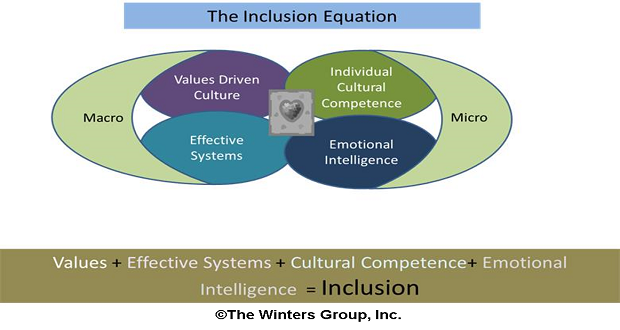As a graduate student completing my masters’ thesis just over seven years ago, I remember struggling to find enough sources to support my initial research proposal and literature review. I entered my masters’ program with an interest in exploring the intersection of diversity, equity, inclusion, and technology, recognizing the critical role that tech continued to play in rapidly evolving not only the workplace but the community and marketplace.
When I entered the second year of my program and started preparing for my final capstone project, I knew that I wanted my work to combine my interests and passion for tech and computer science with my determination to create better workplaces for all.
My topic of choice? Inclusion in virtual environments – more specifically, virtual teams (and if you want to get even more specific – gender diversity in virtual teams). Both theoretically and practically, my research centered on the moderating role of inclusion (the degree to which individuals feel safe, respected, valued, supported, authentic, and engaged) in virtual workplaces.
Week after week, I poured over thick research articles in the library, scribbling notes in the margins. Terms such as virtual team, psychological safety, inclusion, belonging, organizational boundaries, and remote became part of my regular lexicon, much to the annoyance of my friends and family during that time (sorry, Mom and Dad). In addition to reading every book and research article I could get my hands on about the history of virtual teams and technology shifts, I sought out insights from my colleagues. The organization that I was with at that time was developing its first formal telecommuting policy. As a global company, my organization’s leadership had many perspectives on the importance of cultural competency in a dispersed workforce.
As I reviewed research, it became increasingly clear that virtual teams and digital transformation weren’t solely about technology; it was about talent – people. Without an intentional focus on building an inclusive culture, virtual work would not be effective. Inclusion in virtual environments must be even more deliberate than in strictly physical workplaces to account for cultural and technological barriers.
Over four decades after Peter Drucker’s characterization of the knowledge-based economy, organizations face a new challenge: navigating the hybrid workplace. In the face of a global pandemic, many organizations have been forced to reimagine the workplace – not only how and where work gets done, but how to support, engage, and enable a remote workforce.
In the face of a global pandemic, many organizations have been forced to reimagine the workplace - not only how and where work gets done, but how to support, engage, and enable a remote workforce. Share on XThe future of work is hybrid. However, while many organizations recognize the benefits of a hybrid workplace, maintaining company culture is one of the most significant challenges that hybrid organizations will face. With some employees at home and some on-site, it becomes even more critical to be intentional about cultural norms and expectations. Challenges range from creating a space of connection virtually, ensuring all employees have access to needed resources and information, and fairness in performance management and career development opportunities.
According to a recent survey from McKinsey & Company on the future of work, 68% of organizations do not yet have a clear plan, vision, or strategy for remote hybrid work. When many organizations shifted to remote work in the spring of 2020, it was due to necessity – and for most employees, it was a time of physical distancing and isolation. Lines between work and home life were blurred. Ideally, a hybrid approach would present the best of both worlds – a more flexible model that could support both in-office and remote workers.
As organizations center inclusion in their hybrid and return-to-office strategies, they should consider the following factors:
1.) Managers play a critical role in building an inclusive culture and supporting employees.
“Where the leader goes, the organization will follow.” Leaders have always played an essential role in creating and sustaining an environment where all employees feel valued and appreciated and thrive in an organization. Inclusive leadership remains one of the key critical skillsets for leaders and organizations of the future. In an increasingly global and diverse workforce, inclusive leadership is an imperative and strategic competitive advantage. Inclusion is not simply “nice-to-have.” Teams with inclusive leaders are 17% more likely to report that they are high performing, 20% more likely to say they make high-quality decisions, and 29% more likely to report working collaboratively. Even the earliest frameworks on diverse team performance, such as Bruce Tuckman’s framework on the impact of diversity on team performance over time (1965), indicate that well-managed diverse teams can significantly out-perform well-managed homogenous teams over time – but only if managed effectively.
Organizations must prepare their leaders to lead differently in a hybrid workplace. During the height of the pandemic in July 2020, Gartner found that only 13% of company leaders were concerned about creating parity between the remote and in-office experience. Chief among the concerns of managing a hybrid workforce was maintaining corporate culture. But culture isn’t just about free perks like cafeterias and on-site dry cleaning services. In a hybrid environment, leaders must be even more intentional about creating a fair, equitable, and inclusive environment. Leaders can signal this by creating opportunities for their team to connect informally and formally, ensuring their team feels they are accessible, demonstrating vulnerability, and meeting challenges with openness and curiosity.
Orgs must prepare to lead differently in a hybrid workplace. During the height of the pandemic (July 2020), Gartner found only 13% of company leaders were concerned about creating parity between remote and in-office experience. Share on XWhen employees feel that they belong, that they are valued for the unique experiences and perspectives they bring, and that their voices are heard, teams, and organizations perform better.
2.) Employees will look to the organization to provide a place for connection and belonging — both in-person and virtually.
Perhaps one of the most significant challenges facing a hybrid workforce is connection. Over the last year, organizations have had to be intentional about creating spaces for employees to connect, engage, and come together, despite physical distance. Creating a space for connection and belonging is even more critical in a hybrid workplace, where previously employees may have even been rewarded for their “visibility” and working on-site. Employee Resource Groups (ERGs) will continue to play an important role in many organizations to build a place for connection, belonging, and collaboration while fostering empathy, awareness, and understanding of different experiences and cultures. The role of ERGs continues to evolve, with many organizations leveraging their ERGs in their pandemic response.
Creating a space for connection and belonging is even more critical in a hybrid workplace, where previously employees may have even been rewarded for their 'visibility' and working on-site. Share on X
3.) Inclusion is a team sport.
Organizational success does not rely solely on technology, but culture. Resources that seem simple, such as inclusive virtual meeting practices (creating shared expectations of meeting time, assigning roles for attendees ahead of meetings, providing materials and agendas if possible ahead of time) benefit both in-person and remote employees. Encouraging employees to share their perspectives, and valuing those perspectives, can go a long way. Inclusion is not just up to an organization’s HR team or Diversity, Equity, & Inclusion (DEI) function – everyone must play a role in creating a more inclusive culture.
Encouraging employees to share their perspectives, and valuing those perspectives, can go a long way. Inclusion is not just up to an HR team or DEI function - everyone must play a role in creating a more inclusive culture. Share on X
4.) There’s no such thing as too much communication.
When I worked in a Communications role, I often joked that we could post the same news in an e-mail, on our intranet, on a poster, and verbally, and employees would still say that they hadn’t seen the information. Of course, communication is always important in organizations. Still, organizations must also ensure that employees have appropriate access to information and resources to do their jobs effectively in a virtual or remote environment. Is information accessible equitably at your organization, or is it limited to specific job functions, groups, or leadership levels?
Orgs must ensure that employees have access to information and resources to do their jobs in a virtual environment. Is information accessible equitably at your org, or is it limited to specific job functions, groups, or leadership… Share on X
5.) Be intentional about performance and talent management.
Feelings of meritocracy and fairness are among several factors that are strongly linked to employees’ perception of inclusion, in addition to diverse, inclusive leadership, sponsorship, and access to senior leadership. In a hybrid organization, the adage “out of sight, out of mind” may present itself in unconscious (or conscious) biases based on where an employee sits in an organization. Opportunities for development and advancement should be open to all, not just those in the office. Organizations should be intentional about mitigating potential biases in performance and talent management practices. Organizations should carefully examine how projects and roles are assigned, who has historically had access to resources, development opportunities, and power within the organization, and the impact of remote work on job placement and performance.
Opportunities for development and advancement should be open to all, not just those in the office. Organizations should be intentional about mitigating potential biases in performance and talent management practices. Share on XThere is also the added complexity that not all work or jobs can be done effectively remotely. In the early days of the pandemic, the disparities of “essential work” were quickly seen, with Black, Hispanic/Latinx, lower-wage workers, and workers in the service and hospitality industries the least likely to work from home. Social inequalities at the micro and macro level continue to grow with remote work, furthering the divide between those workers who work from their bedrooms and those who must continue to work in primarily public spaces.
Although none of us know entirely what the future will bring, we can expect that the world of work is forever changed. With an intentional focus on inclusion in the approach to hybrid work, organizations can leverage diversity as a competitive advantage, building and sustaining a culture where all can thrive.
Although none of us know entirely what the future will bring, we can expect that the world of work is forever changed. Share on X



















